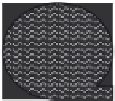Environmental Engineering Reference
In-Depth Information
of interaction mechanisms is the type or class of organic chemicals. The degree of water
miscibility of the organic chemical appears to be a key element. A good example of this is
the difference between nonaqueous phase liquids (NAPLs) and water miscible alcohols.
The family of NAPLs include those that are denser and lighter than water. The DNAPLs
(dense NAPLs) include the organohalides and oxygen-containing organic compounds,
and the LNAPLs (light NAPLs) include gasoline, heating oil, kerosene, and aviation fuel.
Most NAPLs are partially miscible in water. Consideration of the transport of NAPLs in
the saturated zone requires attention to two classes of substances: (1) miscible or dissolved
substances and (2) immiscible substances.
The basic processes involved in transport and fate of NAPLs are demonstrated in Figure
9.16. The chemical properties that affect NAPL transport and fate include (1) volatility,
(2) relative polarity, (3) afinity for SOM or organic contaminants, and (4) density and vis-
cosity. The higher the vapor pressure of the substance, the more likely it is to evaporate.
Movement in the vapor phase is generally by advection. At equilibrium between NAPLs
and the vapor phase, the equilibrium partial pressure of a component is directly related
to the mole fraction and the pure constituent vapor pressure, as described by Raoult's
law. Designating
P
i
as the partial pressure of the constituent,
x
i
as the mole fraction of the
constituent, and
P
i
0
as the vapor pressure of the pure constituent, Raoult's law states that
when equilibrium conditions are obtained, and when the mole fraction of a constituent is
greater than 0.9,
PxP
i i
=
0
.
As Figure 9.16 shows, an organic chemical compound in the soil may be partitioned
between the soil-water, soil-air, and the solid soil constituents. The rate of volatilization
of an organic molecule from an adsorption site on the solid phase in the soil (or in solution
Gaseous
NAPL
Mass transfer
Sorption
Aqueous
Solids
FIGURE 9.16
Processes involved in partitioning and fate of NAPLs.



































































Search WWH ::

Custom Search